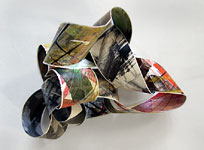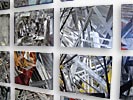|
|
|
ABSTRACT for "PROCESS OF EXISTING!" My work is part of a complex, complicated, set of processes that are simultaneous, on going, multi-layered, ever expanding, ever changing, ever refining, while always maintaining a sense of normality, as they relate to existing. The aesthetic philosophy of existing or being is one that is existential-phenomenological; that combine subjective views of life, and the world with a quasi-scientific philosophical concern. Existentialism is fundamental in its view of human existence, whereas phenomenology is concerned with an analytical look at human behavior. Phenomenology has its roots in the logical and ontological assaults on medieval nominalism and realism, while existentialism fights idealism and positivism. The synthesis of the two was first noted in the work of Franz Brentano (1838-1917) Alexius Meinong (1859-1938) and Edmund Husserl (1853-1920). This synthesis was derived from the Scholastic notion of "intentionality.” According to Arturo B. Fallico, Art and Existentialism, 1962, “…mind or consciousness, by its very nature, 'intends' the object refers to something beyond itself; it is always conscious of something. It is as if, in becoming aware of anything, the mind reaches out for objects whose very character as objects remains tied and bound to the minds act of appropriation. Hence, the primary fact about consciousness is its consciousness of things." Along this same idea, Meinong’s "theory of ideas" views the consciousness of objects as an independent and identifiable object in and of itself. This would include Platonic ideas, different types of perceived feelings, and logical thought. For Husserl, the study of the mind in the act of consciousness as it trying to grasp something beyond itself and including it into the consciousness was a reflexive characteristic. "The mind could therefore achieve a vantage point from which to observe itself from the outside, as it were, as a consciousness whose very nature it is to be in touch with objects." Phenomenology and existentialism strive for clarification of the concrete life-world by posing questions about existing, being and becoming. This is a philosophy that has to do with the discovery of the commonplace, ordinary and obviousness of that which occurs naturally in our existence. Another way of “looking” at being normal. I believe in normality, or the becoming of being normal as the highest level of truth because if its essence of presentness. By objectifying this concept or rather by the process of trying to objectify normality, I establish with myself an infinitely expanding and ever changing paradigm that unifies my existence with truth. Part of this paradigm is my art. I want the viewer to see what there is to be seen both externally and internally; to get beyond the culturally derived preconceptions and predispositions that obscure a direct view of life; to contemplate the infinite, the sublime; to share a sincere approach to the meaning of existing. 

|
|
|

|

|

|

|

|

|
|
For over 30 years I have been fascinated with the symbol for infinity ∞ and what August Ferdinand Mobius invented in 1904, the Mobius Strip. The one sided surface that is constructed from a rectangle by holding one end fixed, rotating the opposite end through 180 degrees and applying it to the first end, making the surface extend indefinitely. This wrapping back allows for infinite possibilities.
Playing with this structure in paper and canvas, I have attempted the simple expression of deep space on a flat surface through overlapping marks that allow the illusion of deep space to fold back on it, complicating the structure to suggest other spatial considerations. When taking a group of such “AFMs” and combining them to form a lyrical, abstract structure, forming yet another layer, it gives the visual environment another possible look at reality. By attaching Velcro to the ends of the rectangles, further possibilities are achieved by the folding and un-folding, attaching and re-attaching the ends of the rectangles to form new compositions. Using “AFMs” as a point of departure, a viewer can become a collaborator/participant in selecting “AFMs” to construct or de-construct combinations or “combines” of “AFMs” to make a personal structure out of the given “AFMs.” "'Reality' is what we take to be true. What we take to be true is what we believe. What we believe is based upon our perceptions. What we perceive depends upon what we look for. What we look for depends on what we think. What we think depends upon what we perceive. What we perceive determines what we believe. What we believe determines what we take to be true. What we take to be true is our reality." -Gary Zukav |
|
|


“Dwelling” is the structure within which one exits. It defines an individual on many levels and all at the same time. Where one lives and works forms the basis for how one perceives the world. The post and lintel basis for most structures sets up a rectangular view, a “window to the world.” One looks out the window or into the TV to get a notion of reality. This reality is based on ones perception of what they take to be real. Perception is often linked to what we look at and how we focus our attention. Focus on a point, and it becomes the center of the universe from which we perceive reality. But if that point becomes a point of departure, one has multiple possibilities for what is real. On the other hand, if one were to develop peripheral vision, as one does in playing basketball, one would not focus on one point, but would focus, or rather not-focus, to allow for multiple points that would create a general impression of what is in front, while becoming aware of the edge or what is at the corners of ones eye. Expanding ones awareness from the narrow to the expansive takes a little practice, but learning to “push-pull” one’s visual perception by focusing or “pushing in” on a specific and “pulling out” to the general and the peripheral, opens up all kinds of realities. I used this technique for a site-specific art installation in 1977. My intention was to flatten out the reality of a 3-dimensional corner of a room. By placing six painted panels into a corner, I could create an illusion of space that would cancel the reality of the real space of the corner. The panels were large, 76 inches by 48 inches. Each panel was painted with overlapping marks to create the illusion of space. The panels in the corner invited the viewer to walk into the corner, the “pull” effect. When the panels filled the viewer's peripheral vision on the right and left, the corner seemed to flatten out or was “pushed” out visually toward the viewer. In 1997, I started a new site-specific installation using 100 drawings. Each drawing was a study of pinched space within a rectangle using marks, color, shapes or fragments, and various illusions of flat and deep space. I ended up making 104 drawings and when I put them up in the studio, a powerful grid of non-objective, abstract work became both individual and general simultaneously. The “push-pull” of visual perception had taken on a new form. I finished the 104 drawings in 2000 and showed a small group of them at the New School University in New York City. It was from that show that I decided to do the 100 paintings. With the combination of drawings and paintings, I realized that I could fill two to four corners of a room. Then one could focus on one piece or use peripheral vision to create their own general work, depending on how and where one looked. Whether any of the corners flatten out in this piece is not the primary concern, but the potential for integration of selectivity with the universal is a step toward a coherent perception of the world. |
main | announcements | statement | current work | projects | CV | contact